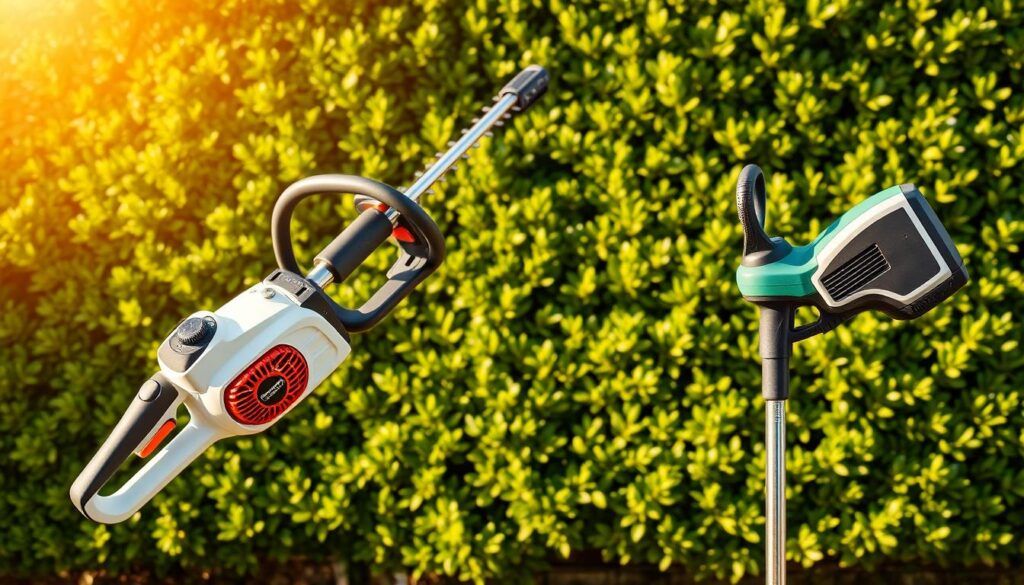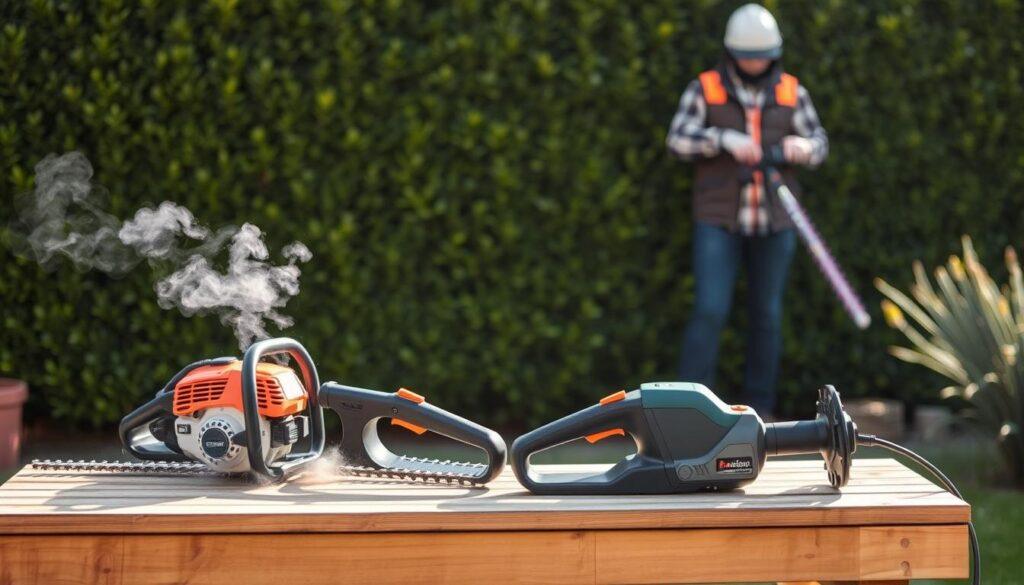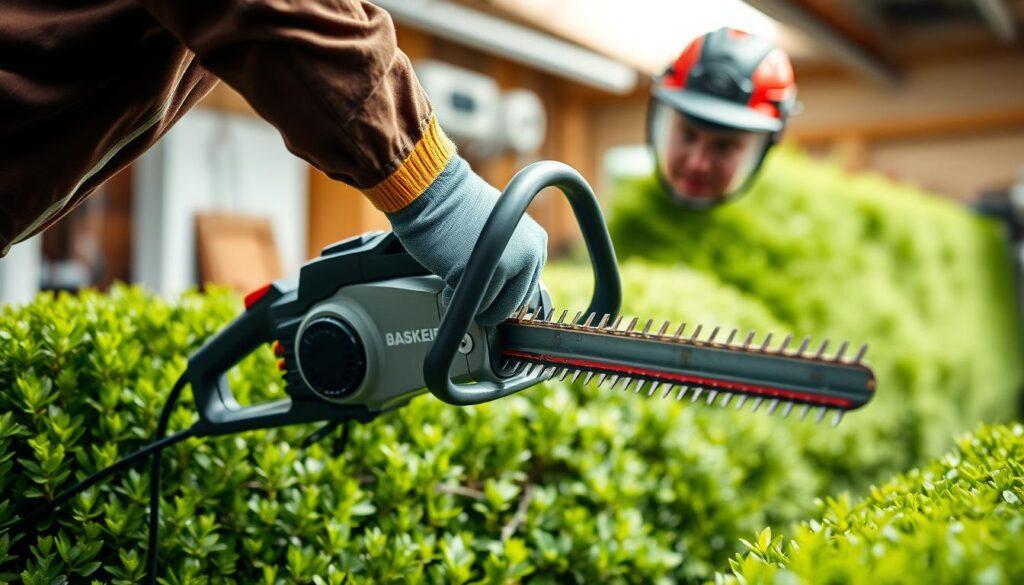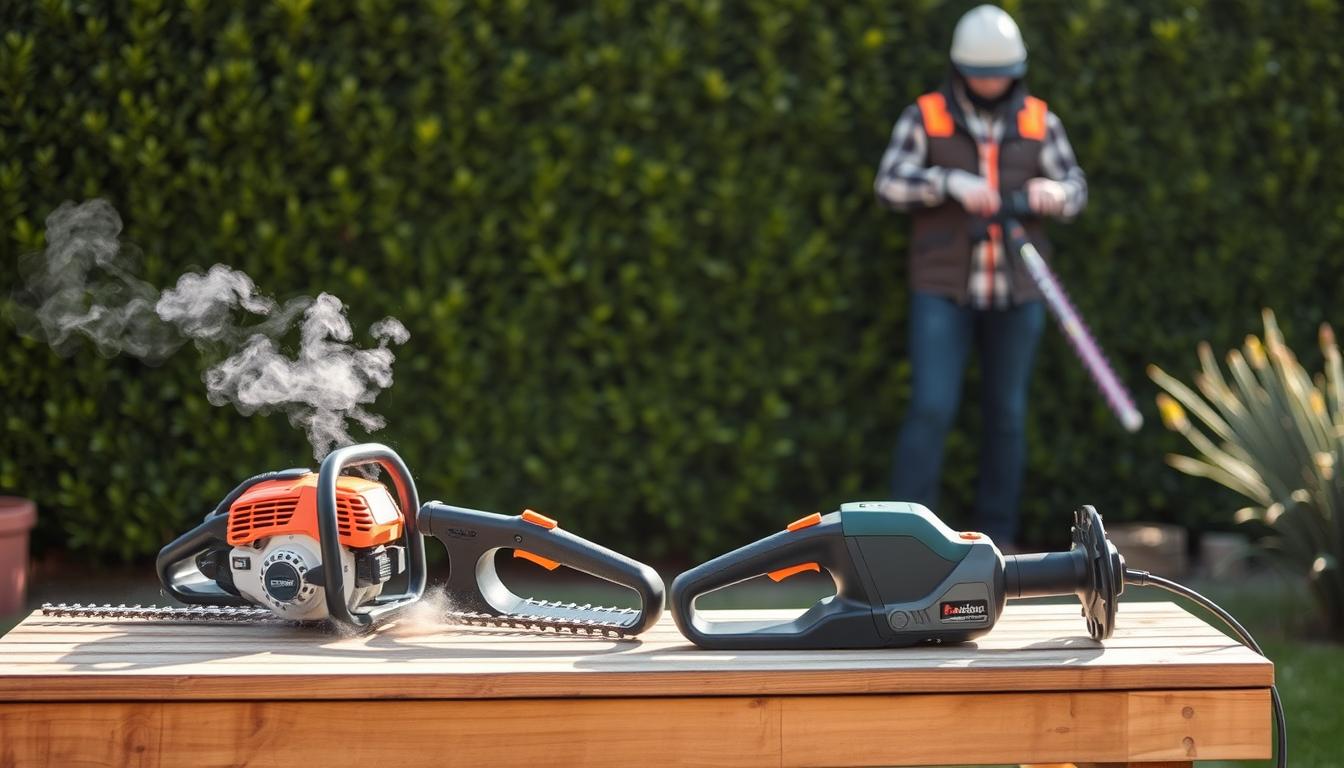Some of the links in this post are affiliate links, which means I may earn a small commission if you make a purchase through those links. This comes at no extra cost to you. Thank you for your support!
Keeping your garden in top shape requires the right tools. A hedge trimmer is a must-have for any gardener. Choosing between gas hedge trimmers and electric hedge trimmers can be tough. This article will help you understand the differences.

You’ll learn about the good and bad of each type. This includes their power, ease of use, and how they affect the environment. By the end, you’ll know which hedge trimmer is best for your garden.
What You Need to Know About Hedge Trimmers
Knowing the basics of hedge trimmers is key for good lawn care. Hedge trimmers are essential for keeping your garden looking great. It’s important to understand how they work to get the best results.
Basic Functions and Components
Hedge trimmers are used to cut and shape hedges, shrubs, and bushes. They have a cutting blade, handle, and power source. The cutting blade moves back and forth to cut through branches.
The handle helps you hold the trimmer comfortably and control it. Some trimmers have adjustable handles for a better fit.
The Evolution of Hedge Trimmer Technology
Hedge trimmer technology has come a long way. There are now better power sources, blade designs, and ergonomic features. These advancements make lawn care easier and faster.
A gardening expert says, “Today’s hedge trimmers are better, with less vibration and more safety features. They’re easier to use.”
“The latest hedge trimmers offer improved performance, reduced vibration, and increased safety features, making them more user-friendly.”
Why Power Source Matters
The power source is crucial for a hedge trimmer’s performance. Gas trimmers are more powerful for thick hedges. Electric trimmers are easier to use and need less upkeep.
| Power Source | Advantages | Disadvantages |
| Gas | More powerful, suitable for thick hedges | Noise, vibration, maintenance required |
| Electric | Convenient, less maintenance, quieter | Less powerful, cord limitations |
Knowing about power sources helps you pick the right hedge trimmer for your needs.
Gas vs Electric Hedge Trimmers
Gas and electric hedge trimmers serve different needs in gardening. Knowing their differences is key to choosing the right one.
Fundamental Differences in Design
Gas hedge trimmers are more powerful for heavy-duty tasks. They use a combustion engine for thick branches and dense hedges. Electric trimmers are lighter and better for the environment. They’re great for smaller gardens and upkeep.
Corded vs. Cordless Electric Options
Electric trimmers come in corded and cordless types. Corded ones provide steady power when plugged in, ideal for small to medium gardens. Cordless models, with rechargeable batteries, offer freedom for larger areas or those who like to move around.
Who Each Type Is Designed For
Gas trimmers are for heavy users or pros with thick hedges and big areas. Electric, especially cordless, suits homeowners with smaller gardens or those who prefer a lighter tool.
| Feature | Gas Hedge Trimmers | Electric Hedge Trimmers |
| Power Source | Combustion Engine | Electric Motor |
| Weight | Heavier | Lighter |
| Environmental Impact | Higher Emissions | Lower Emissions |
Power and Performance Comparison
It’s important to know the difference between gas and electric hedge trimmers. This helps you choose the right one for your garden.
Engine Power vs. Motor Ratings
Gas hedge trimmers have strong engines, measured in cubic centimeters (cc) or horsepower (HP). A bigger engine means better performance, especially for thick branches. Electric trimmers, on the other hand, are rated by motor power in volts (V) for cordless or amps (A) for corded. They might not be as powerful as gas trimmers but are good for regular hedge care.
Cutting Capacity and Blade Types
The cutting power of a hedge trimmer depends on its blade length and type. Longer blades can cut more in one pass but are heavier. Blade types vary, with some for thick branches and others for finer cuts. Key things to think about include:
- Blade Length: Longer for more coverage, shorter for precision.
- Tooth Spacing: Wider spacing for thicker branches, closer for finer cuts.
- Blade Material: High-carbon steel for durability and resistance to corrosion.
Handling Thick Branches and Dense Hedges
For gardens with thick branches or dense hedges, the trimmer’s power and cutting capacity matter a lot. Gas trimmers usually win here because of their high power. But, some top electric trimmers can also handle thick branches. Think about your garden’s needs when choosing:
- Check the thickness and density of your hedges.
- Pick a trimmer with the right power and blade type.
- Also, think about the weight and comfort for long use.
By looking at these points, you can find a hedge trimmer that meets your power, performance, and gardening needs.
Mobility and Range Considerations
When trimming hedges, how easy it is to move around is key, especially for big lawns. The hedge trimmer you pick can really affect how well you can get around your yard.
Working Range of Gas Trimmers
Gas hedge trimmers give you more freedom and reach than electric ones. They don’t need a cord, so you can go anywhere in your yard without being tied down. This is great for big yards or hard-to-reach spots.
Cord Limitations of Electric Models
Electric hedge trimmers, especially corded ones, limit how much you can move. The cord’s length can stop you from getting to every part of your yard. But, corded electric trimmers are lighter and better for short jobs.
Battery Life in Cordless Options
Cordless electric hedge trimmers are a middle ground between gas and electric. Their battery life can be anywhere from 30 minutes to hours, depending on the battery and the hedges you’re cutting.
| Type | Mobility | Range Limitation |
| Gas Trimmers | High | Fuel capacity |
| Corded Electric | Low | Cord length |
| Cordless Electric | Medium to High | Battery life |
Knowing these points can help you pick the best hedge trimmer for your needs. This ensures you can easily keep your hedges looking good.
Weight, Balance, and User Comfort
Using a hedge trimmer that is balanced and comfortable can reduce fatigue and improve your overall trimming experience. When choosing between gas and electric hedge trimmers, understanding their differences in weight, balance, and ergonomic features is crucial.
Typical Weight Ranges by Type
Gas hedge trimmers generally weigh more than electric ones. This is because they have an engine and fuel tank. On average, gas trimmers can weigh between 10 to 15 pounds. Electric trimmers usually weigh between 6 to 10 pounds.
But, there are variations. Some lightweight gas models and heavier-duty electric trimmers exist.
Ergonomic Features and Handling
Ergonomic design is key for user comfort. Many modern hedge trimmers, both gas and electric, have ergonomic handles. These are designed to reduce strain on the hands and wrists.
Some models also have adjustable handles or rotating grips. These features allow for more comfortable trimming positions.
Fatigue Factors During Extended Use
When using a hedge trimmer for extended periods, several factors are important. These include vibration, weight distribution, and grip comfort. Electric trimmers tend to produce less vibration than gas models.
This could reduce user fatigue. However, the overall design and balance of the trimmer also play a big role. They can significantly impact how it feels during prolonged use.
In conclusion, when selecting a hedge trimmer, consider its weight, balance, and ergonomic features. These factors are crucial for a comfortable trimming experience.
Noise and Vibration Impact
Hedge trimmers vary a lot in noise and vibration. This affects you and your neighbors. It’s important to think about these when picking a hedge trimmer. This ensures a quiet and comfortable experience for everyone.
Decibel Ratings Comparison
Gas hedge trimmers are usually louder than electric ones. Decibel ratings can go from 80 dB for electric to over 100 dB for gas. For example, a gas trimmer might be around 95 dB. On the other hand, an electric one might be about 65 dB.
Vibration Effects on User Experience
Vibration can really affect how comfortable you feel while trimming. Electric trimmers usually vibrate less than gas ones. This makes them better for long trimming sessions. Less vibration also means less fatigue and injury risk.

Neighborhood Noise Considerations
If you live in a neighborhood, neighborhood noise matters a lot. Electric hedge trimmers are better for quiet areas because they’re quieter. They help keep the peace, especially in the early morning or late evening.
Maintenance and Longevity
Keeping your hedge trimmer in good shape can make it last longer. Regular care ensures it works well and spots problems early. This helps avoid big issues later on.
Gas Trimmer Maintenance Schedule
Gas hedge trimmers need more care than electric ones. Here’s a schedule to keep yours running smoothly:
- Check and clean the air filter regularly
- Sharpen the blade after every 5 hours of use
- Change the spark plug annually
- Use the correct fuel mixture
Electric Trimmer Upkeep
Electric hedge trimmers are simpler to maintain. Key tasks include:
- Cleaning the trimmer after each use
- Checking the blade for damage
- Lubricating the blade as recommended by the manufacturer
- Storing the trimmer in a dry place
Troubleshooting Common Issues
Both gas and electric trimmers face common problems. Here are fixes for these issues:
Gas Trimmer Problems
- Difficulty starting: Check the spark plug and fuel mixture
- Poor performance: Clean or replace the air filter
Electric Trimmer Problems
- Not turning on: Check the power cord or battery
- Overheating: Allow the trimmer to cool down before resuming use
As, regular maintenance is crucial.
| Maintenance Task | Gas Trimmers | Electric Trimmers |
| Air Filter Cleaning | Regularly | Not Applicable |
| Blade Sharpening | Every 5 hours | As Needed |
| Spark Plug Change | Annually | Not Applicable |
“A well-maintained hedge trimmer is not just about aesthetics; it’s about safety and efficiency in your gardening tasks.”
Environmental Considerations
When picking a hedge trimmer, think about how it affects the planet. Gas and electric models have different impacts on the environment.
Emissions and Carbon Footprint
Gas hedge trimmers release pollutants and increase carbon emissions. “According to the EPA, gas-powered equipment is a significant source of air pollution,” they say. This shows we need cleaner options.
Energy Efficiency Comparison
Electric hedge trimmers use less energy and are more efficient. They turn more of the energy they use into work. This makes them better for the planet.
Eco-Friendly Options and Features
Look for electric hedge trimmers with green features. Things like energy-saving modes or recyclable parts are good. Some have a eco-mode that cuts down energy use.
Choosing an eco-friendly hedge trimmer helps the environment. It reduces your carbon footprint and makes the world a cleaner place.
Safety Features and Considerations
To avoid accidents, it’s key to know the safety features of your hedge trimmer. Both gas and electric hedge trimmers have safety mechanisms. These protect you while you use them.
Built-in Safety Mechanisms
Modern hedge trimmers have safety features like blade guards and safety switches. These prevent accidental starts and protect your hands from the blades. Many models have a dual-action safety switch. You need to press two buttons at once to start the trimmer.
Recommended Safety Gear
Wearing the right safety gear is crucial when using a hedge trimmer. Gloves protect your hands, safety glasses shield your eyes, and ear protection reduces noise. Long sleeves and sturdy pants also help prevent cuts and scratches.
Safe Operating Practices
Following safe operating practices
is vital to minimize risks. Always hold the trimmer firmly, keep the area clear, and avoid overreaching. Be aware of your surroundings, including children, pets, and bystanders.
| Safety Feature | Gas Hedge Trimmers | Electric Hedge Trimmers |
| Blade Guard | Available on most models | Standard on most models |
| Safety Switch | Common feature | Common feature |
| Vibration Reduction | Available on some models | Available on some models |

By understanding and using these safety features and practices, you can greatly reduce injury risks while using your hedge trimmer.
Cost Analysis: Upfront vs. Long-term
The cost of hedge trimmers varies a lot. It’s not just the initial price but also the ongoing costs. When choosing between gas and electric trimmers, think about both the initial cost and the long-term expenses.
Purchase Price Ranges
Gas hedge trimmers cost more upfront than electric ones. Prices for gas models can be from $100 to over $500, based on engine power and brand. Electric trimmers start at $50 for basic corded ones and can reach $300 or more for top cordless models.
Here are some key points to consider regarding purchase prices:
- Gas models: Higher initial investment, with prices ranging from $100 to $500+
- Electric models: Lower to moderate upfront cost, ranging from $50 to $300+
Operational Costs (Fuel/Electricity)
Operational costs are also key. Gas trimmers need fuel, which adds up over time, and oil for lubrication. This increases their costs. Electric trimmers, whether corded or cordless, are cheaper to run, with electricity costs much lower than fuel.
A comparison of operational costs reveals:
- Gas trimmers: Fuel costs can range from $10 to $20 per season, depending on usage.
- Electric trimmers: Electricity costs are minimal, typically less than $5 per year for average use.
Maintenance and Replacement Expenses
Maintenance is also important. Gas hedge trimmers need regular upkeep, like spark plug replacement, air filter cleaning, and blade sharpening. This adds to their cost. Electric hedge trimmers need less maintenance but may still need blade sharpening and battery replacement for cordless models.
To sum up, gas hedge trimmers may have more power but their total cost, including maintenance and operational expenses, can be higher. Electric hedge trimmers are more cost-effective in the long run, especially for smaller to medium-sized gardens.
Matching Trimmer Type to Your Property
Choosing the right trimmer depends on your property’s features. Consider your yard’s size, hedge density, and what you prefer. These factors are key to making a good choice.
Small Yard Solutions
Electric hedge trimmers are perfect for small yards. They are light, easy to handle, and strong enough for small hedges. Look for ones with adjustable handles and small designs for better use.
Medium Property Recommendations
Medium-sized properties need a balance. Cordless electric trimmers are great because they’re mobile and free from cords. They’re perfect for yards that are not too big but still need a lot of hedge care.
Large Property and Professional Needs
Gas-powered hedge trimmers are best for big properties or professional use. They have the power to cut through thick branches and dense hedges for a long time.
Commercial-Grade Options
Commercial-grade hedge trimmers are built for heavy use. They have strong builds, powerful engines, and advanced cutting systems. These are great for professional landscapers who need reliable, top-notch tools.
Heavy-Duty Applications
For very dense hedges or tough trimming jobs, look for trimmers with special features. Reinforced blades and high-torque motors are good for heavy-duty tasks. This equipment is made to handle tough use.
Conclusion: Making Your Final Decision
Now that you’ve weighed the pros and cons of gas and electric hedge trimmers, it’s time to make your final decision. The right hedge trimmer depends on several factors. These include power source, maintenance, and cost. Think about your specific needs, like the size of your property and the type of hedges you need to trim.
If you have a large property with thick hedges, a gas hedge trimmer might be the better choice. It has higher power output. On the other hand, if you have a smaller yard with lighter trimming needs, an electric hedge trimmer could be more suitable. It’s more environmentally friendly and cost-effective.
Your final decision should balance performance, convenience, and your budget. By considering these factors and the information provided, you’ll find the hedge trimmer that best fits your gardening needs. This will make your hedge trimming tasks more efficient and effective.

